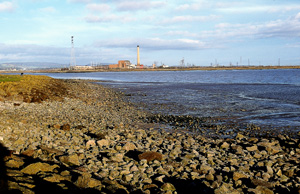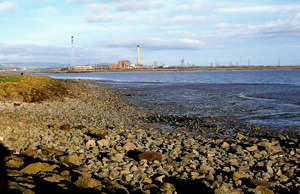| Rocky Bay – noted for silver eels. |
 |
THE River Usk is well known for
 |
its salmon fishing, but the protection measures preventing netting in the estuary has also helped preserve the sea stocks. There are good fishing marks on peat ledges to the east and the sea wall onto mudflats west of the river estuary.
Take junction 24 off the M4, then take the A455 following the signs to Nash/Goldcliff for the east, or junction 28, B4239 towards St Brides and the Lighthouse pub/mobile home park for the west marks. Most of the marks mentioned here are ideal for bass, flounders and eels throughout the summer months, with the chance of codling and whiting during the winter. Farmfields Follow signs to the Power Station, turning into Farmfields Lane. Park in the lay-by at the end. Follow the path to the sea wall but do not disturb birds on the nearby nature reserve.
This mark is best fished on neap tides when it is possible to stay on the peat ledges. Take care because they are slippery. Do not venture onto the soft mudflats. Excellent daytime sole fishing can be had in summer to blow lug or harbour rag. Bass catches increase every year and good silver eels can be taken, along with the occasional flounder. In winter it is good for codling and whiting. There is the chance of a thornback in spring/summer.
The Transporter Bridge
Fishing into the river for sea fish is possible from marks near the bridge. It’s a good place for dads to introduce youngsters to fishing, while mum shops in the city. Whiting and codling follow the incoming tide during the autumn and winter months. Flounder, eel and the occasional school bass are caught with the odd mullet during the summer. Do not venture onto the soft mud.
The Lighthouse Park at the lighthouse pub car park.
Walk as far as possible in an easterly direction. It is possible to fish from the sea wall here two hours before high and two hours after, onto the mudflats. As it is close to the river mouth bass are possible during dry spells in summer to lug and rag. Flounders and silver eels are frequently taken. Codling and whiting show in winter, especially around dusk. Mid-range spring tides are necessary to fish from the wall near the lighthouse.
Rocky Bay and Ridge
Several hundred yards west of the lighthouse is a rocky bay formed by a ridge jutting out onto the mudflats. Rocks and boulders provide a good source of food here and there is a good chance of bass at high water. This mark is also very good for silver eels. You can expect to catch whiting and codling from autumn onwards. On the west side of the ridge is a muddy beach which attracts sole and flounder over high water during the summer.
The Putchers
When salmon were plentiful, putchers were used to catch them as they moved up the tide. The stakes still remain and several can be found along the shoreline west of the lighthouse pub. Food collects at the base of stakes and attracts fish as they move up and down the tide. Fishing close to them will increase your chances. Flounders, eels and chance of a bass in summer, with whiting and codling in winter. This is a high-water-only mark, so check your tides.
Black Pipe
Further west, the sea wall has been rebuilt and strengthened to house discharge pumps. As a result a small shingle bay has formed. Fishing is comfortable from the sea wall into the bay or directly onto the stoney ridge, which covers the pipeline. It is advisable to walk to the mark, as the lane leading to it from the road is not suitable for cars. Good whiting catches are made in autumn. The bay is good for flounder and sole in summer. A double-figure bass was recently caught near here in a match.
Tackle Shops
Garry Evans, 29 Redland Street, Newport. Tel: 01633 855086.
Dave Richards, 73 Church Road, Newport. Tel: 01633 254901.
Pill Angling Centre, 160, Commercial Road, Newport. Tel: 1633 267211.






